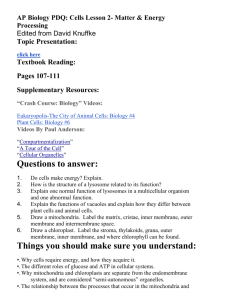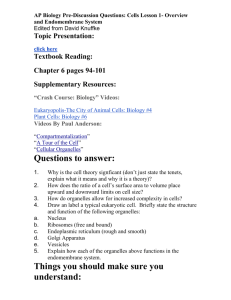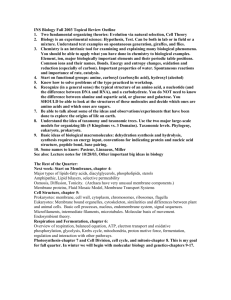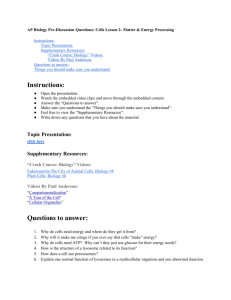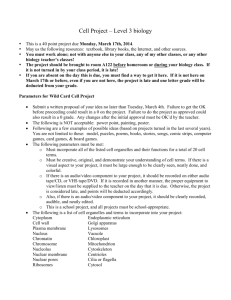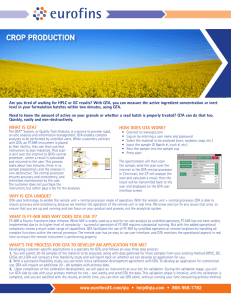Concepts you should make sure you understand
advertisement
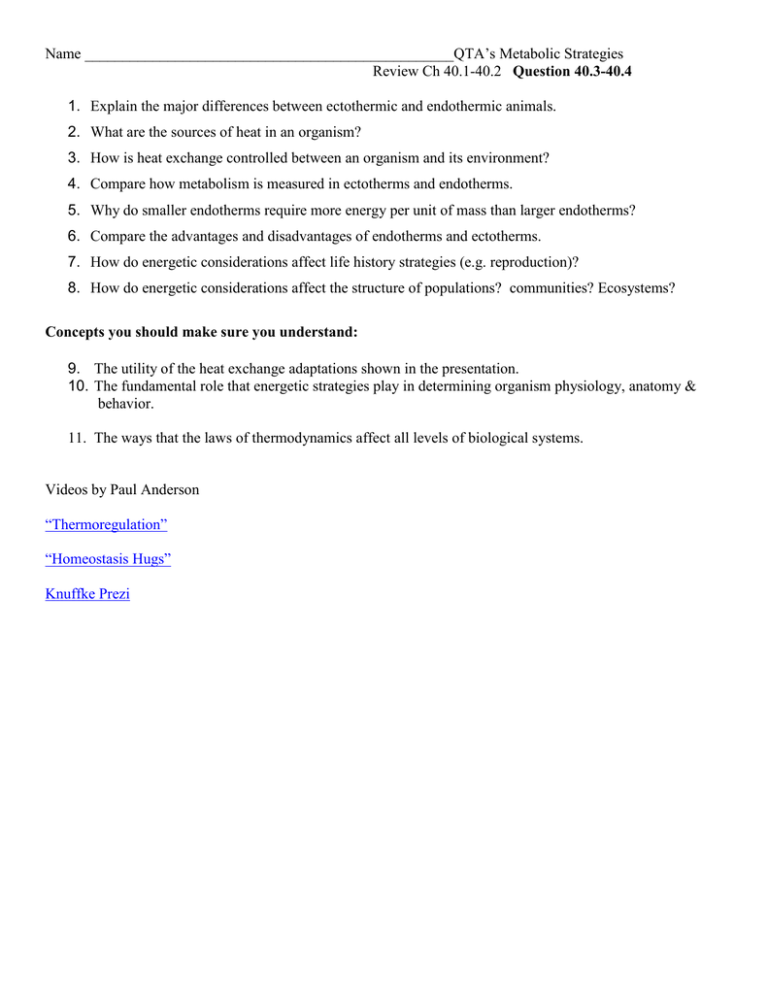
Name _________________________________________________QTA’s Metabolic Strategies Review Ch 40.1-40.2 Question 40.3-40.4 1. Explain the major differences between ectothermic and endothermic animals. 2. What are the sources of heat in an organism? 3. How is heat exchange controlled between an organism and its environment? 4. Compare how metabolism is measured in ectotherms and endotherms. 5. Why do smaller endotherms require more energy per unit of mass than larger endotherms? 6. Compare the advantages and disadvantages of endotherms and ectotherms. 7. How do energetic considerations affect life history strategies (e.g. reproduction)? 8. How do energetic considerations affect the structure of populations? communities? Ecosystems? Concepts you should make sure you understand: 9. The utility of the heat exchange adaptations shown in the presentation. 10. The fundamental role that energetic strategies play in determining organism physiology, anatomy & behavior. 11. The ways that the laws of thermodynamics affect all levels of biological systems. Videos by Paul Anderson “Thermoregulation” “Homeostasis Hugs” Knuffke Prezi Name ______________________________________________________________QTA’s Enzymes 1. How do enzymes catalyze chemical reactions (don’t just say “they lower the activation energy”, give me specific mechanisms). 2. Explain the significance of reaction coupling in living systems. How is it used, and what does it allow living systems to do that they would not be able to do otherwise? 3. Why does the activation energy of many reactions in living systems need to be reduced for living systems to function? 4. Compare the “lock-and-key” model of enzyme function with the “induced fit” model of enzyme function. 5. Explain how each of the following affect enzyme structure and function: i. Substrate concentration ii. temperature iii. pH iv. salt concentration v. cofactors and coenzymes 6. Explain the difference between a competitive inhibitor and a non-competitive inhibitor. 7. How is feedback regulation of enzyme reaction related to allosteric regulation of enzyme function? Concepts You Should Make Sure You Understand 8. Explain why enzymes are classified as catalysts. 9. Identify and list specific examples of enzymes used in all major metabolic pathways in living systems, Be able to explain the reactions that they catalyze. Name __________________________________________________________QTA’s Matter & Energy in Cells 1. Why will it make me cringe if you ever say that cells “make” energy? 2. How is the structure of a lysosome related to its function? 3. Explain one normal function of lysosomes in a multicellular organism and one abnormal function. 4. Explain the functions of vacuoles and explain how they differ between plant cells and animal cells. 5. Draw a mitochondria. Label the matrix, cristae, inner membrane, outer membrane and intermembrane space. 6. Draw a chloroplast. Label the stroma, thylakoids, grana, outer membrane, inner membrane, and where chlorophyll can be found. Concepts you should make sure you understand: 7. Explain why cells require energy, and how they acquire it. 8. Compare and contrast the different roles of glucose and ATP in cellular systems. 9. Infer why mitochondria and chloroplasts are separate from the endomembrane system, and are considered “semi-autonomous” organelles. 10. The relationship between the processes that occur in the mitochondria and the processes that occur in the chloroplast. Name _______________________________________________________QTA’s Structure & Support 1. How does the structure of the cytoskeleton contribute to its function? 2. Diagram an individual phosopholipid and a bilayer of phospholipids. Label the hydrophillic head, and hydrophobic tails in both. 3. Explain the Fluid Mosaic model of the cell membrane and describe the functions of the proteins that are embedded in the membrane. 4. Diagram the cell membrane. Label the following parts: lipid bilayer, integral proteins, peripheral proteins, cholesterol, cytoskeleton, extracellular matrix, glycoproteins, glycolipids. Explain the function of each part of the cell membrane in contributing to the functioning of the cell. 5. If cells can not visually inspect other cells, how do the cells of our immune system know if a particular cell they encounter is part of us or part of another organism? Concepts you should make sure you understand: 6. Identify and describe the structure and function of cillia and flagella. 7. Recognize the structure and functions of the three major components of the cytoskeleton (microfilaments, microtubules, and intermediate filaments). 8. Infer why particular substances will or will not be able to pass through the phospholipid bi-layer of the cell membrane. 9. Explain how membrane-protein structure can allow for portions of the protein to be embedded in the membrane AND allow portions to extend in to and out of the cell. 10. Describe the structure and function of the cell wall. 11. Describe the structure and function of the extracellular matrix. 12. Recognize the differences in structure and function among the types of intercellular junctions found in cells (tight junctions, gap junctions, desmosomes, and plasmodesmata) Name ______________________________________________________________ Cellular Transport 1. How does the second law of thermodynamics allow for diffusion of substances? 2. How is active transport possible, since it contradicts the tendencies of the second law of thermodynamics? 3. Diagram one complete cycle of the Sodium-Potassium pump. Is this active or passive transport? 4. Is it possible for a solution to be both hypertonic and hypotonic? Why or Why not? 5. How do large molecules get taken in to or removed from the cell? Concepts you should make sure you understand: 6. Compare and contrast between simple diffusion, facilitated diffusion, and active transport. 7. Identify where cells get the energy to power active transport. 8. Explain using examples the relationship between osmosis and tonicity. 9. List and describe real world adaptive strategies of animal, plant, and protist cells for dealing with the tonicity of their environments. Check these out! Knuffke’s Prezi on Transport “Crash Course: Biology” Videos: In Da Club - Membranes & Transport: Biology #5 Videos By Paul Anderson: “Cell Membranes” “Transport Across Cell Membranes” Name ___________________________________________________________QTA’s Domains & Prokaryotes 1. Explain why the prokaryote/eukaryote dividing line represents a fundamental division among organisms. 2. Explain why we can infer that the Universal Common Ancestor of all life on earth was: 3. Unicellular 4. Heterotrophic 5. Used DNA as its genetic material 6. Draw and label a typical prokaryotic cell. Briefly describe the function of each part. 7. In eukaryotic cells, chloroplasts are the site of photosynthesis, and mitochondria are the site of aerobic cellular respiration. 8. How are bacteria able to carry out photosynthesis and aerobic cellular respiration without these organelles? 9. Why do bacteria evolve so much faster than multicellular eukaryotes? 10. Generally speaking, why do antibiotics only affect bacterial cells and not eukaryotic cells? Concepts you should make sure you understand: 11. The differences between transformation, transduction, and conjugation, as methods of horizontal transfer of genetic information among bacteria. 12. The following modes of nutrition and give examples of organisms that utilize each one: i. chemoheterotrophic nutrition ii. photoautotrophic nutrition iii. chemoautotrophic nutrition iv. photoheterotrophic nutrition v. 13. Why archea are placed in their own domain of life, even though they have only been known to science since the 1970’s. Knuffke's Prezi: Domains “Crash Course: Biology” Videos: Unicellular Life- Bacteria, Archea, & Protists: Biology #35 Videos By Paul Anderson: “The Three Domains of Life” “Bacteria” “Archea” “Eukarya” Name ______________________________________________ QTA’s Eukaryotes & Endomembrane Systems 1. Why is the cell theory signficant (don’t just state the tenets, explain what it means and why it is a theory)? 2. How does the ratio of a cell’s surface area to volume place upward and downward limits on cell size? 3. How do organelles allow for increased complexity in cells? 4. Draw an label a typical eukaryotic cell. Briefly state the structure and function of the following organelles: i. Nucleus ii. Ribosomes (free and bound) iii. Endoplasmic reticulum (rough and smooth) iv. Golgi Apparatus v. Vessicles 5. Explain how each of the organelles above functions in the endomembrane system. Concepts you should make sure you understand: 6. Infer how advances in microscopy led to advances in cytology. 7. Explain the benefits and disadvantages of light microscopy and electro microscopy. 8. Interpret how the information system of cells (DNA->RNA -> Protein) allows for cells to accomplish all physiological processes Knuffke’s Prezi on Endomembrane System “Crash Course: Biology” Videos: Eukaryopolis-The City of Animal Cells: Biology #4 Plant Cells: Biology #6 Videos By Paul Anderson: “Compartmentalization” “A Tour of the Cell” “Cellular Organelles” Need matter and energy…?
